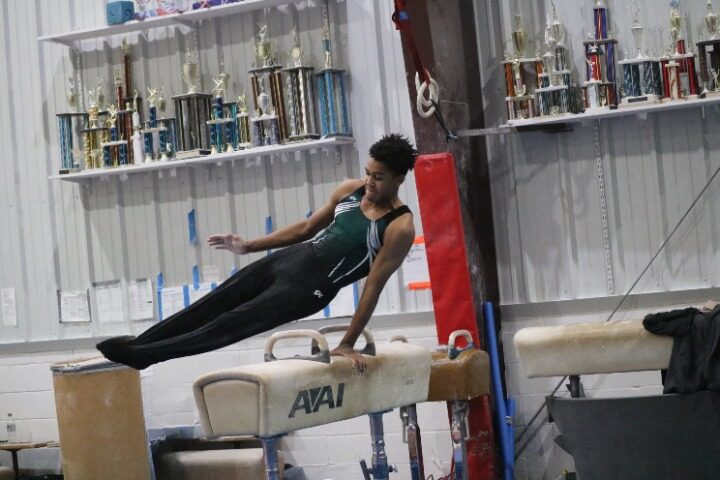If you’re curious about how the pommel horse works and is scored but find gymnasts’ routines confusing, you’re not alone. Although extremely impressive and inspiring, Men’s Gymnastics can be a difficult sport to understand. As one of the hardest events in the sport of gymnastics, pommel horse is no exception.
In this simple summary guide, I will provide insight into what skills gymnasts perform on the pommel horse, why they perform those skills, and how judges evaluate their routines.
How is Pommel Horse Scored?
Judges score Men’s Artistic Gymnastic routines with a difficulty score and execution score.
The difficulty score, or D-Score, indicates how difficult the routine performed was.
The execution score, or E-Score, indicates how well the gymnast executed the routine.
Once the judges find the D-Score and E-Score, they add the two to give the final score. The FIG defines the set of rules that determine how judges score a routine in a document called Code of Points.
A unique event, pommel horse has a few specific rules and deductions. Along with trying to understand the basics of gymnastics, these additional rules make it more challenging for an observer to understand why a routine was performed a certain way or why judges gave a certain score.
However, with a little insight, I don’t believe it is too hard to get a grasp on how pommel horse works. Let’s start by getting a handle on the D-Score.
Evaluating Difficulty on Pommel Horse with the D-Score
In a Men’s Gymnastics routine, the eight highest-difficulty skills count toward the D-Score. More than eight may be performed, but only the most difficult set of skills will count.
The code of points assigns a letter value to each skill indicating its value. For example, ‘A’=0.1, ‘B’=0.2, ‘C’=0.3, … so on. Judges calculate the final D-Score by adding the eight highest-valued skills and the value obtained from element groups.

As with other apparatuses, the code of points divides skills on the pommel horse into four element groups that organize similar movement patterns. The element groups on horse are:
- Element Group I (EG I) – Single Leg Swings and Scissors
- Element Group II (EG II) – Circles
- Element Group III (EG III) – Travels
- Element Group IV (EG IV) – Dismounts
Fulfilling the element groups grants the gymnast +0.5 (five-tenths) to the D-Score. To fulfill an element group, a gymnast must perform a D-value element or higher from that group. But, if only a C or lower skill is performed, the gymnast receives partial fulfillment of +0.3.
What are the Element Groups? What Common Skills Fit in Each Group?
To achieve the highest difficulty possible, it’s in the gymnast’s best interest to have a skill from each element group. That’s why you see a variety of skills in a gymnast’s routine. So what do these element groups look like, and what skills fulfill them?
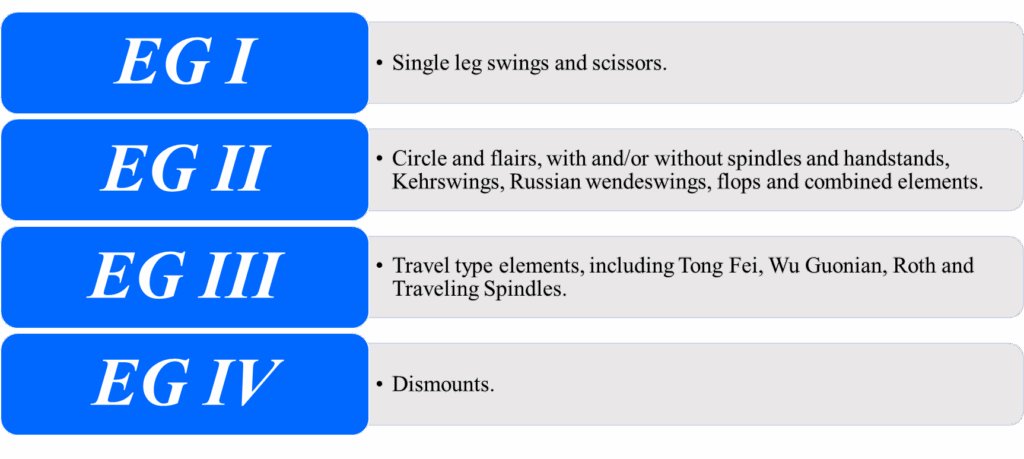
EG I – Single Leg Swings and Scissors
Skills involving moving straddled legs like a pendulum, single-leg swings and scissors are distinct from the other skills on the pommel horse. Excellent scissors involve swinging the legs as high as possible and keeping the legs as wide as possible. Often placed at the beginning of the routine, common skills at the elite level include the Mikulak (D), a full scissor traveling the length of the horse, and the scissor to handstand (D).
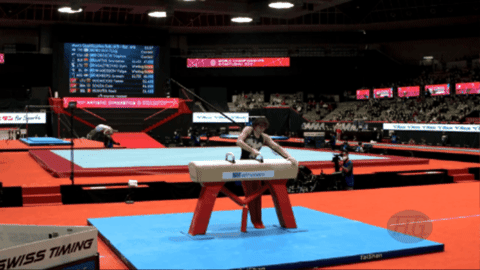
EG II – Circles
Circles compose the largest portion of a gymnastics routine. Quite fitting of the name, the circle starts in a push-up position and the gymnast swings his legs and shoulders in a circle all the way around to return to the push-up position. Circle elements start and end in this push-up, or front support, position. Basic circle skills include:
- Stocklis – Skills involving circles with turns. Similar skills to stocklis where gymnasts perform all turning on one arm are called a Kehrs.
- Spindles – skills where the body turns the opposite way the circle is moving. This creates the illusion that the circle is speeding up.
- Russians– Skills where the gymnasts continue the circle but moves the hands to stay in front support the whole time.
- Flairs – Circling elements where the legs are straddled wide.
More difficult variations of these skills involve performing them on more challenging parts of the horse such as in the saddle of the horse or over the handles. For example, a full spindle performed on the end of the horse is a D, but performed in the saddle of the horse upgrades to an F. Another way to gain value, gymnasts can perform combinations of circle skills on a single pommel, called FLOP sequences.
Also, many elite pommel workers do Full Kehrs, such as the Sohn (D) and Bezugo (E). These skills perform a 360 degree turn on one arm and a single pommel. Although extremely challenging, full kehrs are also extremely efficient skills that provide high value in only one circle.
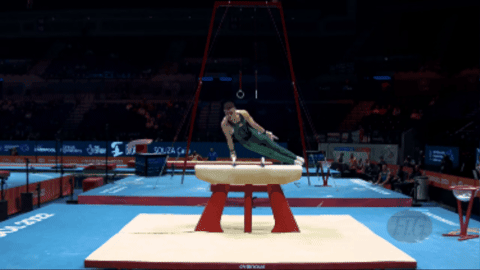
EG III – Travels
The travel group involves performing circles that move from where they started. Often travels move across the whole length of the horse, but not always. Gymnasts can perform many of the basic circle variations as travels. Most common are the Magyar (D), a forward travel, and Sivado (D), a backward travel. Other common skills include the Roth (D) and Wu-Guonian (E), a single and double Russian travel respectively.
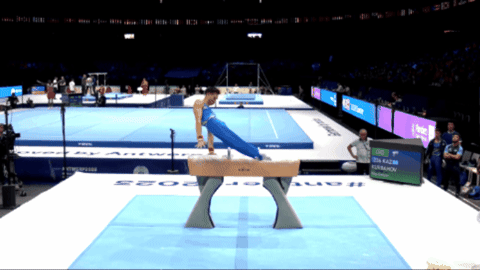
EG IV – Dismounts
Gymnasts perform one of either two types of dismounts on pommel horse, a Russian dismount or Handstand dismount. The highest value Russian dismount is a triple Russian (D). Handstand dismounts are more common. During handstand dismounts, the type of entry determines difficulty value, and pirouetting increases difficulty. The highest value horse dismount (E) is a stockli to handstand with 450 degrees of turning (or 1 + 1/4 turns).
Due to stringent rules in the code of points, gymnasts may not receive credit for the dismount in a few scenarios. Of course, if the gymnast falls they get no credit. However, large errors, such as swinging with a visible show of strength or lowering the hips or legs while rising to handstand, will also cause the gymnast to lose credit.
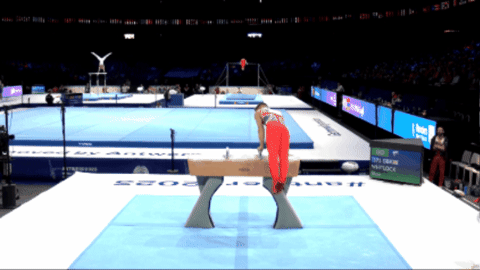
| EG I Scissors | EG II Circles | EG III Travels | EG IV Dismounts |
|---|---|---|---|
| Scissor – A | Circle or Loop – A | Magyar – D | Double Russian – B |
| Full Scissor – B | Moore or Stockli – B | Sivado – D | Circle to Handstand – B |
| Traveling Full Scissor – C | Triple Russian – C | Roth – D | Circle to Handstand with 270 degree Pirouette – C |
| Mikulak – D | Sohn – D | Wu – E | Stockli to Handstand with 450 degree Pirouette – E |
Horse Execution and Common Deductions
The E-Score, measuring the quality of a routine, starts at a 10.0 in gymnastics. Judges take deductions from the execution when gymnasts make mistakes in their routine. Along with form deductions that apply to every event, such as leg form, feet, and arm bends, horse has several specific deductions as well. See below the horse-specific deductions indicated in the Code of Points:
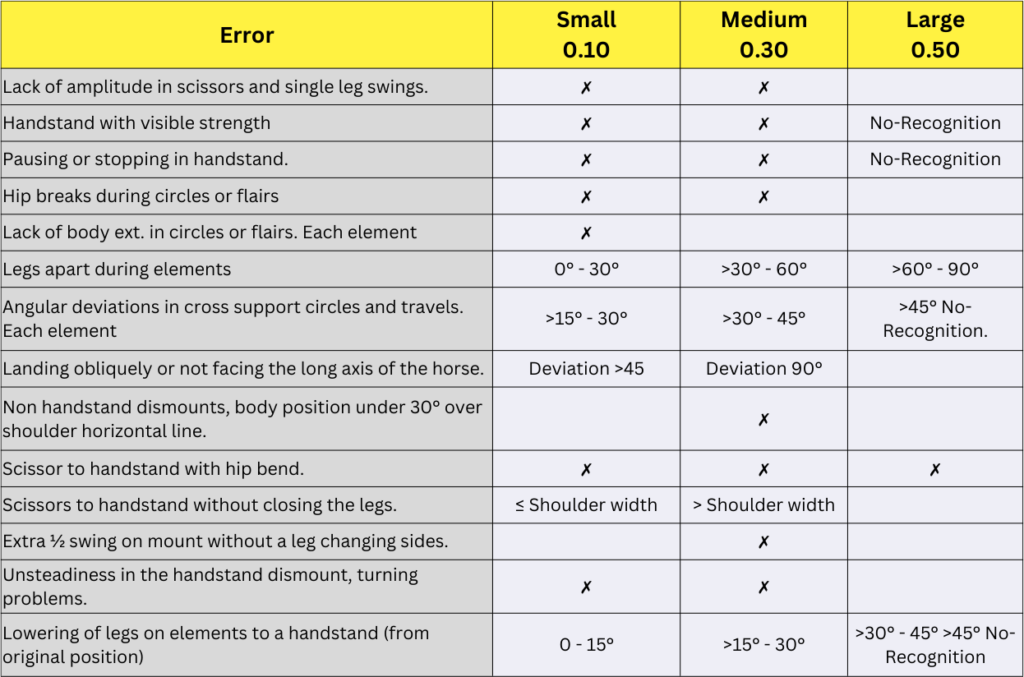
We can draw attention to a few deductions in particular:
– Lack of extension in circles and flairs as well as hip breaks in circles in flairs. Common on horse, these often result in a large portion of the deduction in some athletes routines.
– Lack of amplitude on scissors or single leg swings. All scissors or legs swings must swing above shoulder height. Likewise, scissors must display a large separation of the legs.
– Show of strength, pausing, or lowering on handstand elements. These deductions if severe enough will result in a large deduction and loss of skill credit, so these are very important for gymnasts to avoid.
Judges also interpret some general deductions differently on horse. For example, brushing or hitting the horse results in deductions based on context. On scissor elements, judges ignore most brushing, as some contact is unavoidable. However, a hit or sit on the horse will result in either a large error. On other elements, a brush may be a small deduction -0.1 while a hit would be large deduction -0.5.
If you are a gymnast or parent of a gymnast who is looking for some equipment to improve their circles on horse, check out these 6 great mushrooms for gymnastics. If you found this article helpful, leave a comment and let us know what content you want next.

